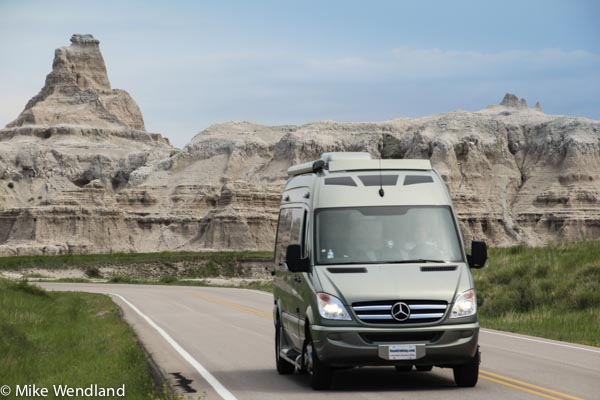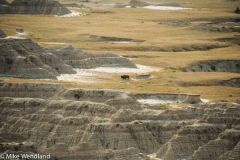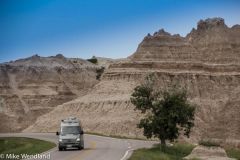RV Must-Do Trip: The Badlands of South Dakota
 It’s easy to see why American Indians and the early settlers called the area of southwestern South Dakota the Badlands.
It’s easy to see why American Indians and the early settlers called the area of southwestern South Dakota the Badlands.
They are dry, unbearably hot in the summer, rugged, isolated and - in the days before modern transportation – extremely difficult to navigate.
But while it may be an inhospitable place to live, these days the Badlands make for a very good visit by RV.
Jennifer and I try to spend time here each year. You could say we’ve gotten hooked on the Badlands.
The Badlands National Park protects 242,756 acres of sharply eroded buttes, pinnacles, and spires blended with the largest undisturbed mixed grass prairie in the United States.
There is a rugged beauty about the place like none other we have seen anywhere in North America.
You will see bison, bighorn sheep and prairie dogs throughout the park, sometimes far off, sometimes surprisngly close. On the down side, you need to be snake aware out here. Prairie rattlesnakes abound.
The Badlands were formed by the geologic processes of deposition and erosion. Deposition of sediments began 69 million years ago when an ancient sea stretched across what is now the Great Plains. After the sea retreated, successive land environments, including rivers and flood plains, continued to deposit sediments. Although the major period of deposition ended 28 million years ago, significant erosion of the Badlands did not begin until a mere half a million years ago. Erosion continues to carve the Badlands buttes today. Eventually, the Badlands will completely erode away.
During the Age of Dinosaurs, a warm, shallow sea covered the Great Plains, including what is now Badlands. As a result, the Badlands contain one of the world’s richest fossil beds.
Since dinosaurs were land creatures, no fossils of these animals have been found in the park. Giant marine lizards called mosasaurs swam in the ancient sea, along with sea turtles and fish.
The park is open year round, though we seem to always visit in the summer. Temperatures can easily hit 100 degrees during the day. So we plan our hiking and bike riding in the early morning.
The badlands are a photographer’s dream location.
The craggy spires and wide open spaces seem to look different with every glance, every time the sun goes behind a cloud, and as the day draws to an end. Sunrises and sunsets here are spectacular.
Three days and two nights are the minimum time to spend if you want to see most of the park. We always budget a visit of that long as we’re either heading west towards Yellowstone, or back home towards Michigan.
Getting to the Badlands is easy. Interstate 90 (I-90) is located directly north of the park and provides access to the Hwy 240 Badlands Loop Road. For those traveling west on I-90, take Exit 131 (Interior) and follow the signs directing vehicles south approximately three miles to the Northeast Entrance. For those traveling east on I-90, take Exit 110 at Wall, South Dakota. Follow signs directing vehicles south approximately seven miles to the Pinnacles Entrance.
State Highway 44 provides an alternate, scenic access to the park and intersects Highway 377 in the town of Interior. Follow 377 two miles north to the Interior Entrance.
When we leave the Badlands, we prefer driving the two lanes of Highway 44 west to the Black Hills area instead of heading back to I-90.
There are three campgrounds to choose from. Two are operated by the National Park Service - Cedar Pass Campground and Sage Creek Campground.
Cedar Pass is located near the Ben Reifel Visitor Center and has 96 level sites with scenic views of the badlands formations. Camping fees are $18 per night per campsite, or $30 per night for campsites with electrical hook-ups. A dump station is available for a $1.00 per use fee. Cold running water, flush toilets, and covered picnic tables are available. In the summer, it’s often filled.
Sage Creek is a primitive campground. You are apt to have bison wandering about the campground. It’s located on the west side of the park’s North Unit, near the Badlands Wilderness Area. Access is located off of the Sage Creek Rim Road, an unpaved road that may temporarily close after winter storms and spring rains. The road provides limited turnarounds for large recreational vehicles, but Type B and C motorhomes have no problems. Camping here is free. There is no electricity or water, but there are pit toilets and covered picnic tables. This campground rarely fills up.
The third area campground is the White River KOA, located about four miles outside of the park. This is our favorite spot to stay in the Badlands. It is located in a quiet, rural area with large shade trees beside the White River. There’s a great dirt road right across the street from the campground that is perfect for bike rides Believe me, the shade of the campground is well appreciated, as is the swimming pool.
The Badlands: Put it on your must visit list.
And even if you have been there before, I bet, like Jennifer and me, you, too, want to keep returning.
Right?












0 Comments
Recommended Comments
There are no comments to display.
Please sign in to comment
You will be able to leave a comment after signing in
Sign In Now